
Cold War Watchtower
Delta Lima 3 - Green DL3-G
The Story of the Cold War Watchtower DL3-G
In the early 1950's the United States Air Force ran a civilian volunteer program called Operation Skywatch, in which the volunteer Ground Observation Corps manned Ground Observation Defense Posts 24 hours a day.
... radar warning systems had not yet been developed to effectively track low-flying aircraft. As a result, volunteer American citizens were asked to man a 24-hour sky watch at various locations. Suspicious air traffic was to be reported to the United States Air Force by telephone to alert major cities and military installations and prevent a sneak attack reminiscent of Pearl Harbor. [IS]
According to a 1996 article in the Lafayette Journal and Courier:
There was a lot of talk of a Soviet — North Korean link and Soviet planes sneaking over the North Pole with the intent of bombing electrical facilities in Tennesee. [LJC]
The first post commissioned nationwide was just north of West Lafayette, Indiana. The tower, restored in 1976 and with a memorial at its base, still stands.

In August 1952 a wooden watch tower was commissioned by the USAF in Cairo, Indiana, a small community of 19 people in northern Tippecanoe County, north of West Lafayette. It was designated DL3-G, or Delta-Lima-Three Green, and was the first Ground Observation Defense Post commissioned nationwide. According to a 1996 article:
Other Tippecanoe County watch towers included Crane Station, Romney, West Point, and the roof of the Lafayette Bank and Trust building in Lafayette. [LJC 1996]
The tower was built behind the home of Larry O'Connor, a former USN Chief Petty Officer who then ran the grocery, the only store in Cairo. That store, at the interestion of Tippecanoe County roads 100 West and 850 North, is now his home. He had moved to Cairo in 1949, and was asked through the Indiana governor's office to organize a sky watch post.
What little remains of the community of Cairo is at the intersection of Tippecanoe County roads 150W and 850N, fairly close to (but isolated from) interstate highway I-65.

We are approaching the intersection in the first picture below.
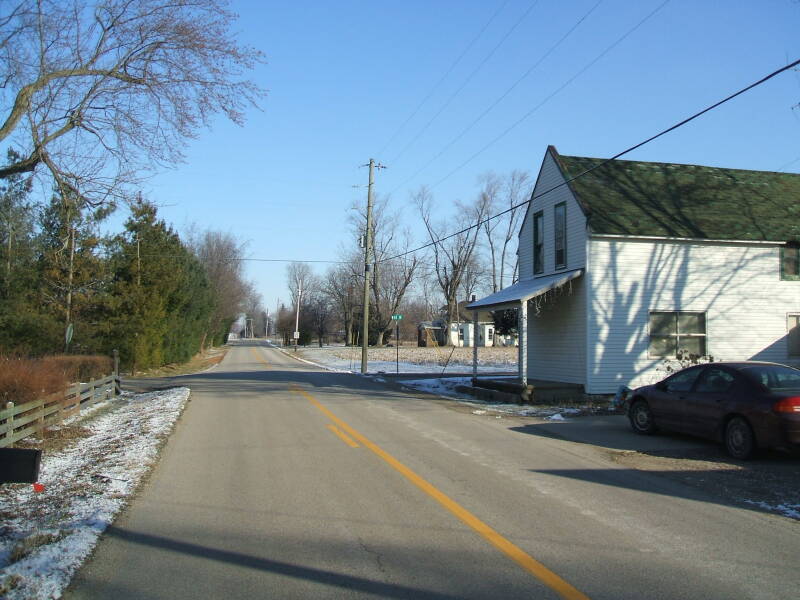
Then we turn to the east and see the tower just ahead.

Amazon
ASIN: 1521288577
The sky watch started in mid to late 1950 with volunteers standing in O'Connor's back yard only during weekends. They then used the back of the Cairo store with a dedicated telephone line linked to a regional USAF "filter center" in South Bend, Indiana.
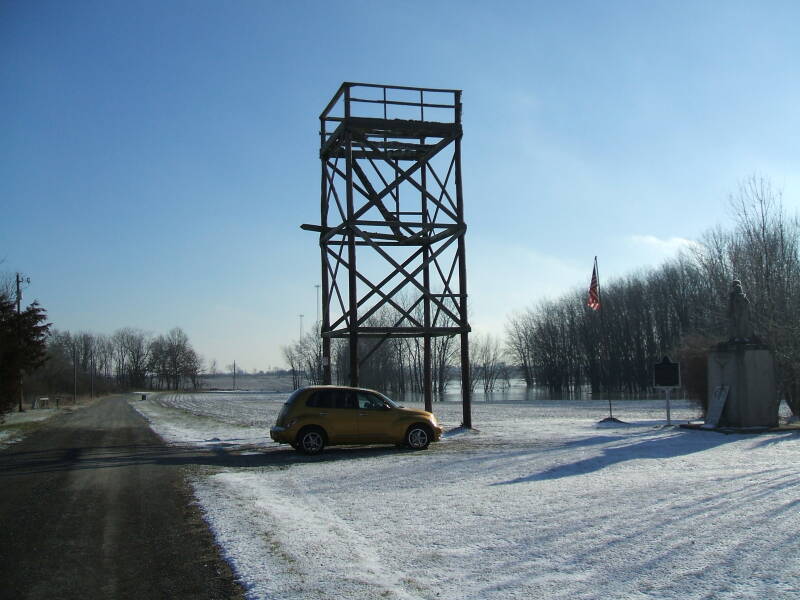
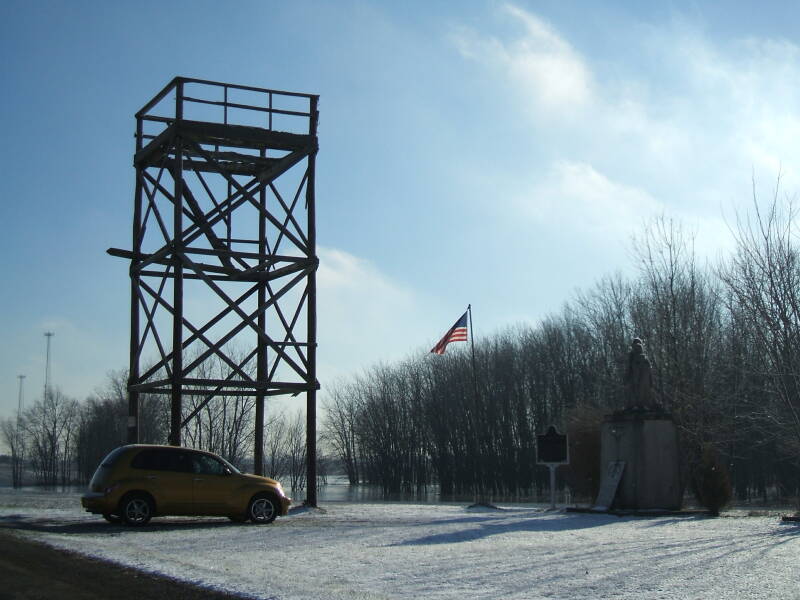
Amazon
ASIN: B005VRLL5A
The tower went up in 1952. It was built of four utility poles 30 feet tall, with a 12x12 foot platform on the top, holding a 7x7 foot cabin surrounded by a railed balcony. The tower was commissioned by the USAF on 16 August 1952 in a ceremony attended by about 500 people.
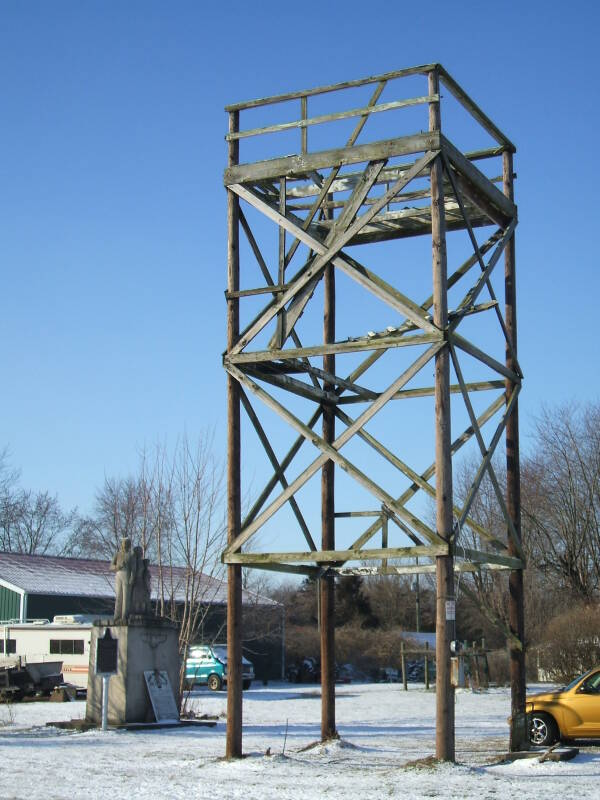
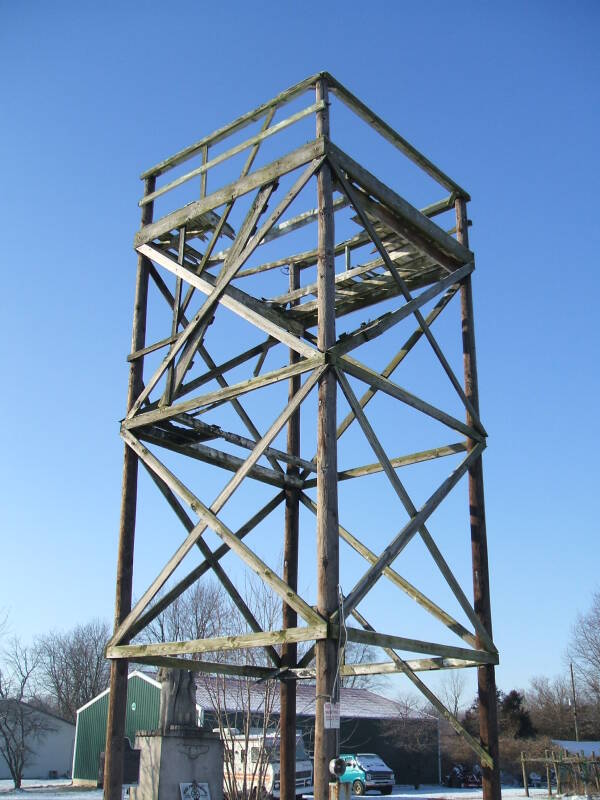
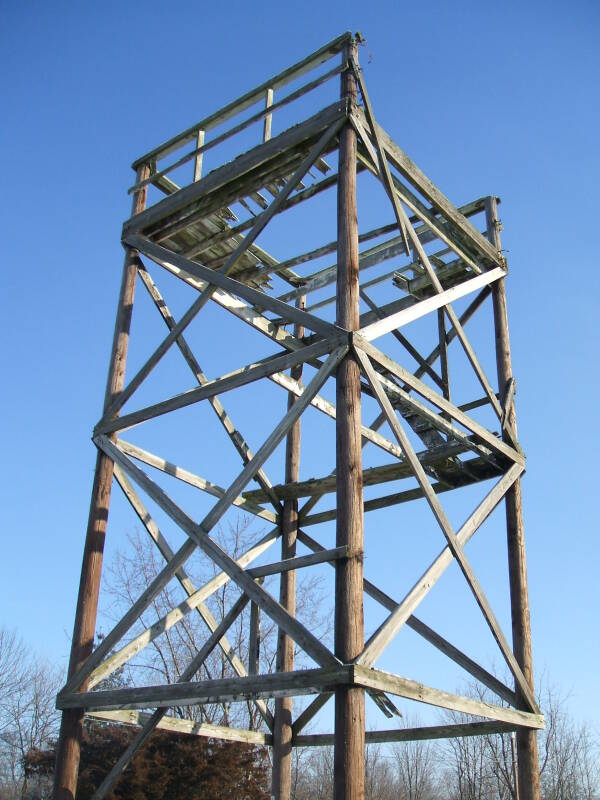

There were 90 to 120 volunteers who stood two hour watches 24 hours a day for a little over a year. The volunteers were largely organized through the Grange, a rural organization largely made up of farmers.
Colonel James T. Emmett was the state coordinator of the Ground Observation Corps. The USAF filter center in South Bend was commanded by Captain Forest R. Shafer. Military and affiliated organizations listed in the program from the commissioning ceremony were:
- 4671st Ground Observer Squadron, 30th Air Division
- Eastern Air Defense Force
- Air Defense Command, United States Air Force
- Indiana Wing, Civil Air Patrol
According to O'Connor, at times the USAF would fly aircraft in the vicinity of DL3-G without informing the observers. The flights were probably out of Bunker Hill AFB (a Strategic Air Command base near Peru, Indiana, which was renamed Grissom AFB in 1968). The expectation was that the aircraft would be detected, accurately identified, and reported to the USAF report filter center in South Bend over the dedicated telephone link. (see the Analysis section below for more on this)
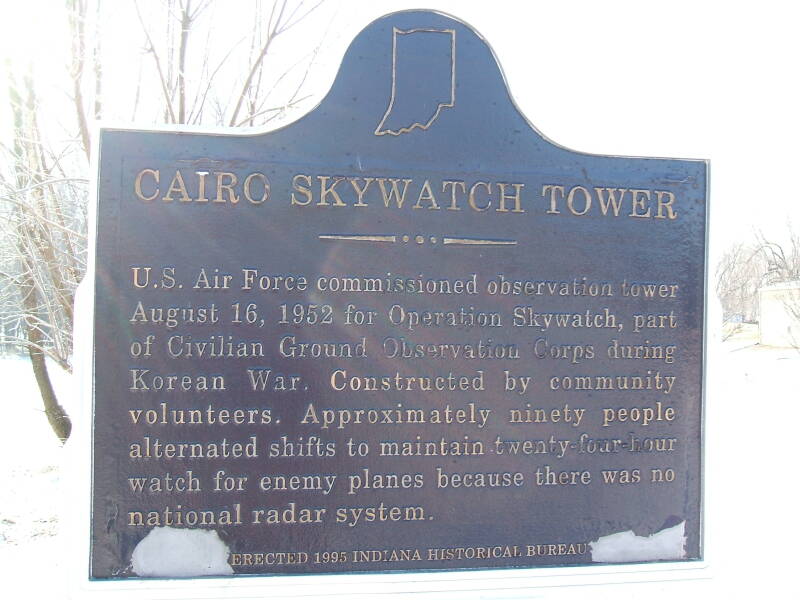
The Ground Observation Corps program was scaled back in 1954 after the end of the Korean War, and the Cairo tower ceased operation. By the 1970's "Operation Skywatch" was a part of Civil Defense using volunteer severe weather spotters. In 1976 the tower was reconstructed, and a statue was commissioned for the memorial. In 1978 the Tippecanoe County Park Board considered, but did not create, a 15-acre park centered on the tower. In 1980 funds were raised to pay for the statue and to install it at the memorial.
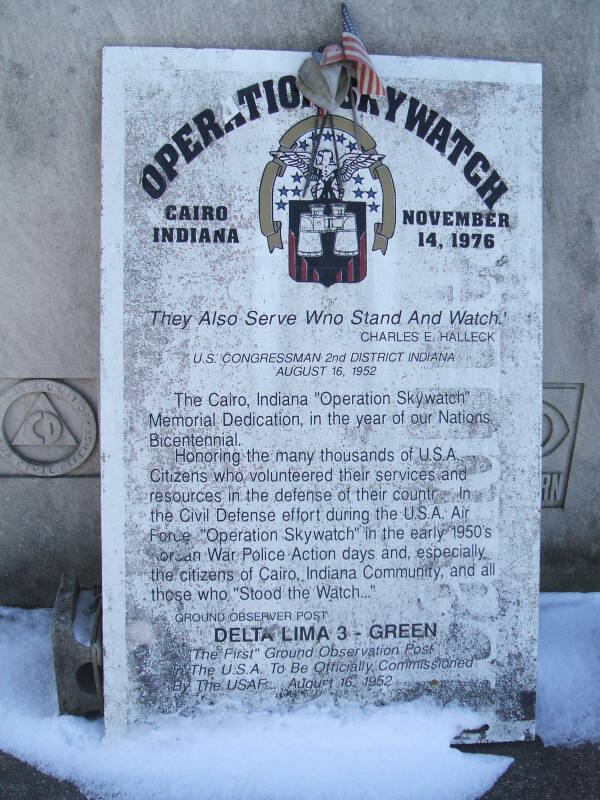
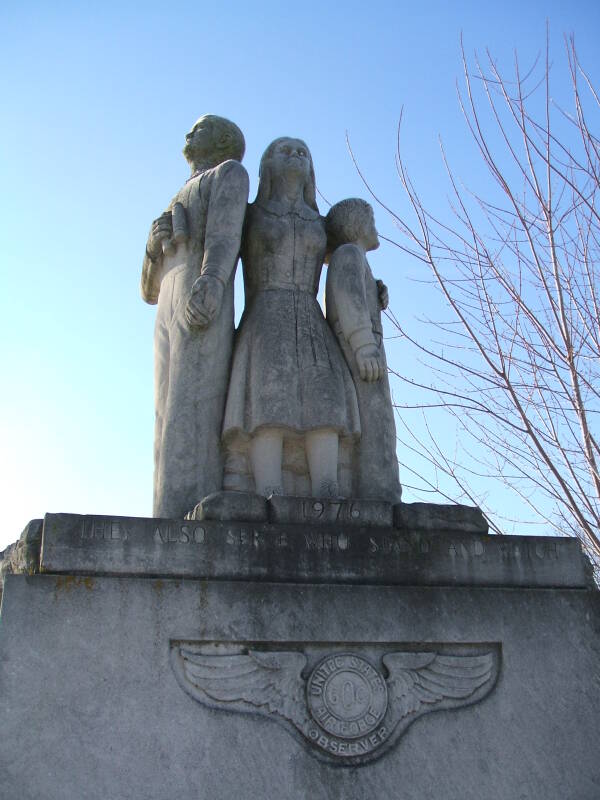
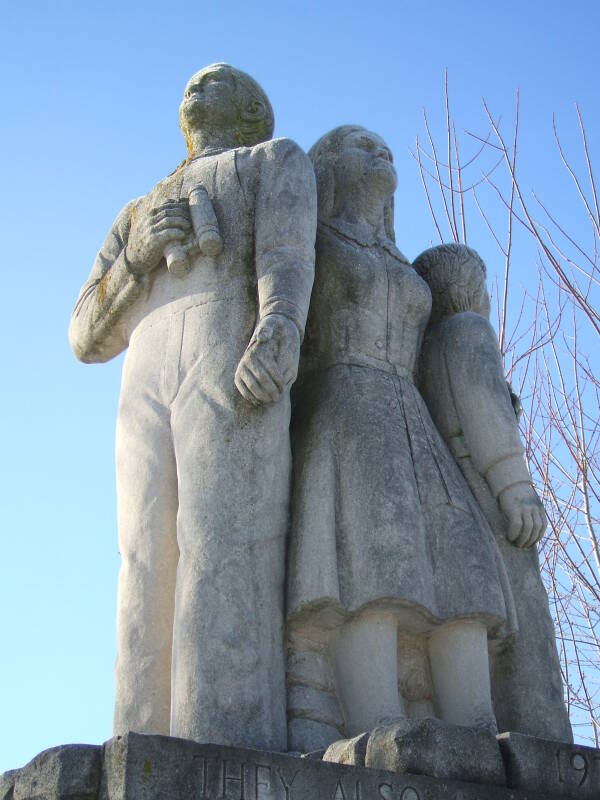
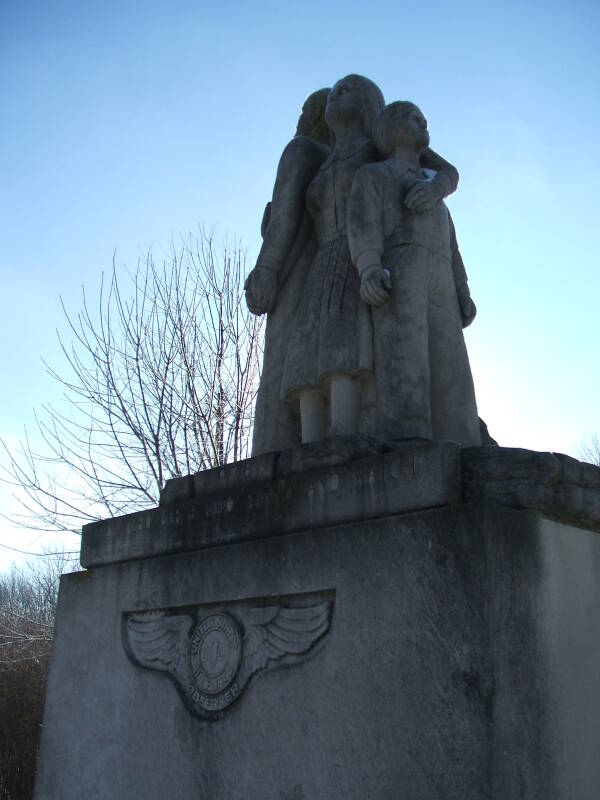
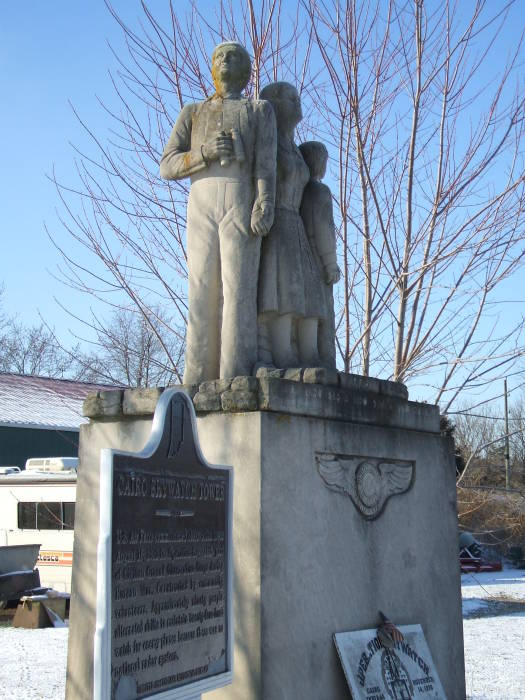


The Location of DL3-G and Further Details
The tower is on Tippecanoe County road 850 North
just east of 100 West.
N 40° 32.418 W 086° 55.434 (WGS84)
UTM: 16T E 506444 N 4487730 (WGS84)
See the Google map.
Roadside America has listed this among their sights to see in Indiana.
Analysis — Were Soviet bombers really expected over Indiana?
First, it seems highly unlikely that SAC analysis would conclude that Soviet strategic doctrine called for a first strike against the Tennessee Valley Authority.
Far more likely first strike targets would depend on Soviet intentions. Major population centers if the primary goal was massive loss of life. National command and control targets (Washington DC and SAC headquarters in Omaha, Nebraska) if the primary goal was swift military disablement. Or strategic weapons systems (SAC missile and bomber bases) if the primary goal was minimizing U.S. retaliation capability.
Destruction of hydroelectric installations would be part of a longer term strategy aimed at disabling industrial output. TVA would be a target in a U.S.A.-U.S.S.R. strategic war, just not a target in the initial strike.
Second, flight from any Soviet military airfield to DL3-G would require flying over Canada, Alaska (in the case of Eastern Siberian airfields), and other obvious targets like major U.S. population centers (Minneapolis, Chicago, and Detroit) and SAC bases (Montana, North and South Dakota) before passing over DL3-G. See a great-circle map centered on DL3-G and showing Soviet air bases, based on a list of Russian air bases compiled at GlobalSecurity.org.

Click here for the full-sized map showing Soviet bomber bases and DLG-3.
While Ground Observation Defense Posts around the perimeter of the country could have been of defensive value, it seems unlikely that Soviet bombers were expected to be first spotted while flying over north-central Indiana. My guess is that DL3-G and similar posts were used to evaluate civilian detection of USAF aircraft by visual and auditory means. In plain terms, would the average person notice and recognize them?
From 1947 through 1969 the USAF ran Project Blue Book, which ostensibly investigated unidentified flying objects that at times mystified the USAF. In the late 1990's it was revealed that the aims of Project Blue Book included concealing the existence and capabilities of advanced USAF reconnaisance craft such as the U-2 and SR-71, and analyzing the likelihood of their detection by civilian observers. Reports of UFOs to Project Blue Book were compared against logs of reconnaisance aircraft flights. The observers making the reports were never told of the real nature of what they saw — either "natural phenomena" or something the USAF said remained a mystery. [CIA, NYT, WP]
It stands to reason that the USSR had a project very similar to the Ground Observation Corps (undoubtedly non-volunteer!), and the USAF knew or at least suspected this. USAF mission planning needed some estimate of the likelihood that U.S. aircraft would be spotted by ground-based observers. The Ground Observer Corps could provide much-needed data.
Timeline
January 1943
Bunker Hill NAS is activated near Peru, Indiana.
[AFM]
16 August 1952
Cairo watch tower was commissioned.
[LJC: 14,15,17,18 Aug 1952]
June 1954
Bunker Hill AFB is reactivated near Peru, Indiana.
It became a Strategic Air Command base for tankers.
[AFM]
1954
DLG-3 was decommissioned after the Korean War ended.
[LJC]
May 1968
Bunker Hill AFB was renamed Grissom AFB.
[AFM]
1976
The tower was reconstructed for the
U.S. Bicentennial celebration.
[LJC]
November 1976
The memorial was dedicated at the reconstructed tower.
[LJC]
February 1977
Memorial statue was carved to commemorate the watch tower.
(although its $8000 price was not
paid by the county for some time)
[LJC]
August 1978
Tippecanoe County Park Board considered forming a 15-acre park.
[LJC]
May 1980
The statue was finally installed at the tower.
[LJC]
October 1994
Grissom AFB was realigned as USAF Reserve base.
[AFM]
References
- [AFM] Air Force Magazine, May 2003, pg 152.
- [CIA id="CIA"] The CIA and the U-2 Program, 1954-1974, Gregory W. Pendlow and Donald E. Welzenbach, Central Intelligence Agency, 1998, pp. 72-73. Also see a relevant quote at: http://www.history.navy.mil/faqs/faq29-2.htm
- [GS] GlobalSecurity.org, list of Russian military airfields (most of them, if not all, former USSR military) at http://www.globalsecurity.org/military/world/russia/airfield.htm
- [IRN] Indiana Rural News (REMC publication), Oct 1952, pg 5.
-
[IS] Indianapolis Star
- 17 Aug 1952 sec 2 pg 2;
- 1 Aug 1976 sec 4 pg 4.
-
[LJC] Lafayette Journal and Courier
- 14 Aug 1952 pg 1;
- 15 Aug 1952 pg 11;
- 17 Aug 1952 section 2 pg 2;
- 18 Aug 1952 pg 1;
- 12 Oct 1953;
- 12 May 1973;
- 11 Jul 1976 pg B-1;
- 15 Nov 1976 pg 10;
- 22 Nov 1976;
- 21 Jan 1978;
- 16 Aug 1978, pg 1;
- 16 Jun 1979;
- 22 Jun 1979 pg A-12;
- 10 May 1980;
- 1 Jun 1992 pg A-7;
- 22 Sep 1996.
- [LO] Discussion with Larry O'Connor, Memorial Day, 2002
- [NYT] New York Times, 8 Aug 1997, pg A27, "Big Lies and Little Green Men", David Wise
- [TCHA] Tippecanoe County Historical Association
- [WP] Washington Post, 5 Aug 1997, pg A4, "Cold War UFO Coverup Shielded Spy Planes", Dana Priest
- Also see the Ground Observer Corps page.
Also see my other Cold War related pages.